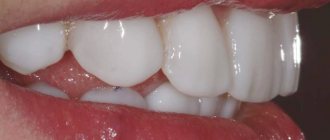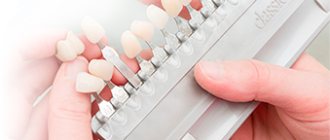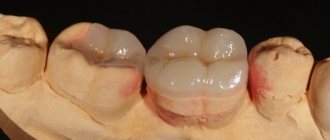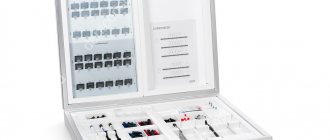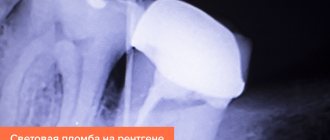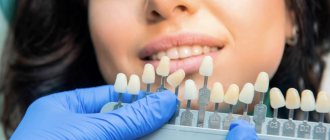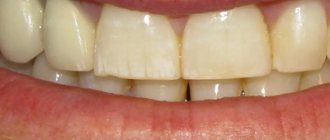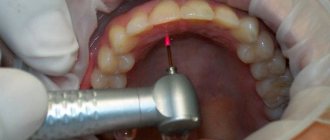Advantages over classic products
Dentists recommend E-MAX veneers to their patients for aesthetic restoration, since the products are endowed with quality indicators:
- The material has high strength , because it is a type of lithium silicate glass ceramics.
- Modern ceramic linings are produced by pressing. As a result of the absence of pores and tension in the material of the structure, it acquires a smooth, uniform surface.
This property allows the production of very thin veneers (thickness comparable to a contact lens). Thanks to this feature, there is no need to sharpen the teeth. - Fixed using dental glue , which protects the enamel from caries.
- The presence of a wide range of shades and transparency of the enamel is designed for a wide range of patients.
- Precise positioning of the structure on the tooth is achieved through 3D computer modeling, which eliminates all errors.
- The records are durable ; they do not fade or fade over time. Even after ten years, they will look like they were just made.
- Plaque does not accumulate on the onlays, and tartar does not form on them.
- The material is suitable even for allergy sufferers , has high biocompatibility and does not enter into chemical reactions with saliva and other liquids.
- There is no gum destruction around the restored area.
Conventional linings may have a number of disadvantages compared to E-MAX products:
- With insufficient care, food particles may get between the product and the dental element, which can trigger the development of caries.
- During installation, a mandatory manipulation is grinding off the protective layer of the unit being restored.
- Products can be made according to a template.
- Short service life (7 years with good care).
The characteristic features of conventional structures and those manufactured using E-MAX technology are given in the comparative table:
| Feature | E-MAX | Ceramics |
| Strength | High. The risk of chipping is minimal | Relative |
| Construction technology | CAD/CAM technology is used. The use of 3D modeling increases the accuracy of pad positioning | Manual creation from a cast or template |
| Installation | In some cases, fixation is possible without removing the enamel | Mandatory removal of enamel to the thickness of the plate |
| Aesthetics | Very high. The plates look natural. The color scheme matches the natural shade | High. Ceramic veneers are invisible on teeth |
| Lining life | From 15 years and older | On average 7-10 years |
| Cost in rubles | At least 20 thousand | From 10 thousand |
Why are veneers popular?
Veneers are installed on the upper and lower frontal teeth. These are thin petal overlays comparable to lenses. They are mounted on the front of the tooth. Their thickness is small - up to 0.5 mm.
Therefore, the elements are imperceptible when worn. This ensures concealment of defects and creates a visual effect of naturalness of all teeth.
Indications
Like any prosthetics, the use of onlays has certain indications and limitations for their installation.
Dental plates made in Germany allow you to get rid of the following disadvantages:
- changes in the color of the enamel associated with certain diseases, taking medications, smoking, excessive consumption of coloring drinks (coffee, tea) that cause spotting or yellowing;
- darkening of old fillings;
- presence of defects in the form of cracks, chips;
- incorrect orientation of the incisors (rotation around an axis, slight crowding);
- thinning and erosion of enamel;
- the presence of interdental gaps (diastema, trema);
- violation of the shape and position of the incisors due to malocclusion;
- in the absence of effect after other restoration techniques.
Features of the manufacture of Cerec veneers and the technique of their installation.
Let's talk here about the pros and cons of solid metal-ceramic crowns.
At this address https://www.vash-dentist.ru/protezirovanie/nesemnyie-p/koronki-np/zolotyie.html we will tell you in which case it is justified to install a gold crown on a tooth.
In what cases are they indicated?
This type of permanent prosthetics makes it possible to restore teeth if you have:
- enamel defects: chips, cracks, stains;
- discoloration as a result of the use of medications;
- yellowed teeth;
- interdental gaps;
- small teeth;
- single incisors protruding from a row;
- crooked teeth;
- ugly fillings.
Contraindications
E-MAX veneers have a number of contraindications for installation. They are the same as for regular records:
- severe destruction of the incisors as a result of caries;
- pathological abrasion;
- malocclusion (straight);
- bruxism;
- presence of bad habits, for example, biting hard objects;
- destruction of the enamel on the inside or the presence of an old filling of large sizes;
- complete neglect of hygiene procedures;
- high risk of incisor injury (for example, when doing boxing).
Veneers will not help correct defects such as a straight bite or loss of a significant amount of tooth tissue.
Advantages and disadvantages
Like any medical intervention, veneering has its advantages and some disadvantages.
Advantages
- The onlays accurately repeat the anatomy of the tooth, they are simply not noticed in the mouth;
- they do not change color, after 10-15 years the veneer will be the same as on the day of installation;
- abrasion resistant;
- bioinert, do not cause allergic reactions;
- resistant to food dyes, you can use any food;
- wear-resistant - modern veneers last up to 20 years.
Flaws
- They cannot be repaired; if a piece breaks off, the veneer will have to be replaced;
- veneers remain unchanged, which can make them stand out from natural teeth, which change color over the years;
- they do not make teeth stronger, they do not eliminate imperfections, but only mask them;
- before installation, the teeth are prepared;
- irreversibility - once you install veneers, you will have to do it forever.
Manufacturing stages
Since the linings are individual products, their production involves several stages:
- The dental technician uses wax to model the plate so that it fits perfectly on the surface of the incisor.
- To make onlays, the technician uses blanks from E-MAX ceramics.
- The technician places such a blank in a special oven, where, by pressing, it is transformed into an overlay similar to the wax plate made earlier.
- Further processing of the finished product is carried out manually.
- The inner surface of the lining is roughened for a stronger fixation.
- To give the enamel a natural shine, the plate is coated with glaze.
- Next, a color scheme is selected to match the color of the patient’s teeth.
Watch the video to see how E max veneers are made.
Types of ceramic veneers
On the one hand, all the linings in question are ceramic. Basically, this means that no metal is used in their manufacture.
On the other hand, they are classified according to different criteria.
Manufacturing methods
All ceramic linings are made in several ways.
The first one is refractory
. Ceramic layers are gradually applied to a platinum plate that follows the contour of the tooth and fired. The enamel layer is gradually increased from the neck to the cutting edge, and the dentine layer is cut in the opposite direction. Then the product is adjusted, given a natural look and sent to the clinic.
The second method is layer-by-layer production
. He is the most in demand. Thus, products are made from modern ceramic mixtures - E-max, Empress. Using the pressing method, a thin plate is formed, which is then covered with glaze, giving the teeth a natural shine.
Computer modeling in the manufacture of microprostheses – CAD/CAM – is becoming increasingly widespread. The doctor scans the surface of the teeth, and then a computer program models the onlay. The veneer is milled from a ceramic block on a milling machine. Then it is tinted and glazed.
Material of manufacture
It is not easy to understand the difference between ceramics, porcelain and glass ceramics. All this is one concept: ceramics. It’s just that different mixtures give rise to different properties, and at the same time new terms:
- E-max:
glass ceramic based on lithium disilicate. A very durable material that allows you to imitate tooth enamel down to the smallest detail. - Empress:
glass ceramic based on leucite, with the ability to transmit light, which brings it as close as possible to natural enamel. - Ceramage:
microceramic based on zirconium silicate, combines strength and transparency, just like real teeth. - Zirkonzahn:
Zirconium dioxide is the strongest dental material available today. It is not as transparent as the others, so the smile turns out to be truly “snow-white”.
Pre-treatment procedures and installation
Prosthetics with E-MAX veneers are carried out in several stages:
- The dentist prepares the surface of the incisor. If necessary, it is turned (removing the top layer of enamel 0.5-0.7 mm thick).
- An impression is then made using a special paste and sent to a dental laboratory.
- To prevent the patient from feeling discomfort, temporary onlays are made in the laboratory while the permanent plates are being made.
- Based on the impression, the technician makes a plaster model and then a temporary product.
- Using a set of samples, the dentist selects the desired shade to match the rest of the patient’s dentition.
Before finally fixing the permanent product, the dentist must make sure that the shape and shade match the element being restored.
If there are any deficiencies, the specialist will make adjustments. If the veneer fits perfectly on the incisor, then the next step should be to check the bite and contact with neighboring elements.
After checking all the indicators, if there are no comments, the dentist begins the final fixation of the structure on the tooth.
The restored element is treated with a special gel to enhance strength, and then cement is applied and a veneer is attached. Excess glue is removed with a special tool.
The main differences between Duo PCH veneers and products from other manufacturers.
This publication contains detailed information about ultranir.
Here https://www.vash-dentist.ru/protezirovanie/nesemnyie-p/viniryi-np/restavratsii-komponirami.html we will talk about compositers and indications for their use.
Rules of care
If certain care rules are followed, the service life of the plates can be extended.
After restoration, it is advisable to follow the dentist’s recommendations:
- Daily oral hygiene is required at least twice a day (morning and evening) using paste, brushes and other oral care devices. This will provide shine to the product.
- Avoid eating solid foods.
- It is forbidden to crack nuts or chew seeds.
- Minimize the consumption of products containing dyes.
- At least twice a year, undergo a preventive examination by a specialist.
- It is necessary to remove dental plaque once every six months.
- Use a mouthguard for bruxism.
- Visit the dentist at least once every six months to correct the dental plate.
Life time
The service life of ceramic linings with proper care is up to 10 years. But, products may fail earlier in the following cases:
- If the cement under the structure fails. Then the plate may fall out. The veneer must be taken to a dentist, who will professionally reattach it.
- If a hard object hits the elements of the dentition while eating, biting nuts, or uncorking bottles with your teeth, the lining may crack.
Price
The cost of dental restoration with E-MAX veneers depends on the region, the status of the clinic, the qualifications of the specialist and the clinical case. The average price for producing records in Moscow is at least 25,000 rubles.
The cost is comparable to the installation of zirconium structures. When planning dental restoration with modern onlays, it is necessary to take into account the possible costs of preparatory procedures: caries treatment, professional cleaning.
How much prosthetics costs in Moscow clinics can be seen from the table below:
| Procedure | Cost (in rubles) |
| Professional teeth cleaning | 3 000—4 000 |
| Ceramic or zirconium dioxide veneer | from 20 000 |
| Composite cover | from 5 000 |
| Lumineers | from 35 000 |
| Ultraneers | from 20 000 |
| Enamel whitening | from 10 000 |
| Diagnostics | from 1 000 |
| Taking impressions | 500 |
| Treatment of caries | from 1 500 |
| Making temporary crowns | from 4 000 |
| UltranirEnamik (Vita, Germany) | from 25 000 |
| Ultraneer (Lumineer) Cerinat (USA) | from 30 000 |
| Ultra-thin veneer e-max | from 25 000 |
Disadvantages of E-max –
- High cost - compared to standard metal ceramics (but at the same time it is comparable to the cost of highly aesthetic metal ceramics with “shoulder mass”),
- not on chewing teeth (on 6-7-8),
- not allowed with bruxism,
- it is impossible if the stump of the ground tooth is dark in color,
- it is not advisable if there are a large number of missing teeth (in this case, the entire chewing load is not distributed evenly, but only on the remaining teeth, leading to their overload). We hope that our article on the topic: E-max metal-free ceramic crown, price, reviews was useful to you!
Sources :
1. Personal experience as a dentist, 2. National Library of Medicine (USA), 3. Harvard Medical School (USA), 4. https://www.ivoclarvivadent.us/, 5. https://www .realself.com/, 6. “Crowns and bridges in prosthetic dentistry” (Smith B.).
Reviews
Every person wants to have a flawless and healthy smile. Veneers are about aesthetics and preserving the functions of the restored units. But how effective are they and how long will they last?
Patients who have already tested this restoration method on themselves share their impressions. Many of them were pleased with the changes.
Some people complain that it takes a long time to get used to new teeth. In general, reviews of the use of E-MAX technology are positive.
You can also share your impressions of the restoration in the comments to this article.
If you find an error, please select a piece of text and press Ctrl+Enter.
Tags veneers fixed dentures
Did you like the article? stay tuned
Previous article
Rating of dental implant manufacturers according to experts and patients
Next article
Polyurethane dentures are an ideal budget solution to the problem

